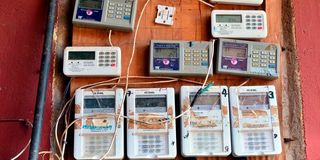Relief for consumers as electricity prices fall for third consecutive month

A prepaid electricity token machine provided by Kenya Power at an apartment in Nairobi. Epra has reduced power prices by Sh2.1 per unit.
The energy regulator has reduced power prices by Sh2.1 per unit, helping lower the cost of lighting up homes and running industries for the third month in a row, and handing relief to consumers.
In the latest review of electricity charges, the Energy and Petroleum Regulatory Authority (Epra) has cut the Fuel Energy Cost (FEC) by Sh0.38 to Sh3.26 per unit, down from Sh3.64 last month.
The decline is due to a lower dispatch of expensive thermal power in recent months due to a preference for cheaper hydro, geothermal, and imports, particularly from the neighbouring Ethiopia.
The authority has also cut the Foreign Exchange Rate Fluctuation Adjustment (Ferfa) by Sh1.72 from Sh3.68 per unit to Sh1.96. This has led to a total reduction of power costs by Sh2.1 per unit.
This is due to reduced electricity purchase payments by Kenya Power, which foots the costs to independent power producers (IPPs) in foreign currency.
New tariffs
The reduction means that a unit of electricity is retailing at an average of Sh26 for domestic ordinary customers, the lowest power price since April last year when the energy regulator approved new tariffs.
FEC and Ferfa are the largest variable costs in power bills and are adjusted monthly. The Water Resources Authority (WRA) levy is also changed monthly but forms only a tiny share of the bill. The decline in power prices is a major boost for households and businesses, and will further help ease inflationary pressures.
But Kenya’s power costs remain high forcing consumers, especially large users such as commercial and industrial firms shift to own-source generation to cut costs.
The total capacity of captive power plants in Kenya has been on a rapid rise in recent years, hitting 449.5MW as of December 2023. Captive power plants refer to electricity generation units utilised by commercial or industrial consumers to meet their internal electricity requirements.
This marks a growth of 60.1 per cent from 280.76MW just a year earlier.
The lower April power prices come at a time when the cost of living has eased in recent months, with year-on-year inflation dropping to a 2-year low of wes.





